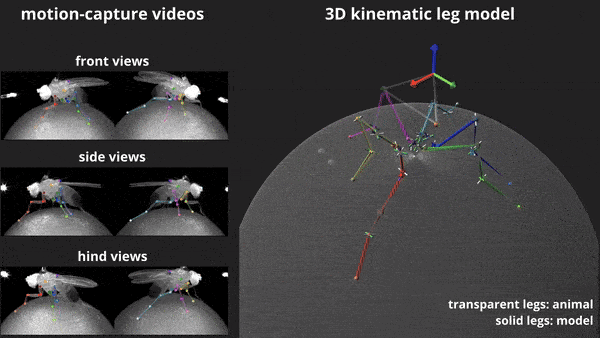
Bonn, July 17, 2024 — In a groundbreaking study published in Frontiers in Bioengineering and Biotechnology, Moritz Haustein, a postdoctoral researcher in the iBehave network, supervised by Prof. Dr. Ansgar Büschges, has developed an innovative 3D kinematic leg model to study the joint kinematics of walking in Drosophila melanogaster. This research represent a significant step towards understanding how the nervous system governs locomotor behaviors.
Drosophila melanogaster, commonly known as the fruit fly, has emerged as a key model organism for studying neural control of behavior. Precise characterization of leg movements is essential for understanding the motor control systems underlying these behaviors. Dr. Haustein and his colleagues addressed this by creating a 3D kinematic leg model that accurately reproduces the natural leg postures of fruit flies during forward stepping. The model was refined using 3D motion-captured leg movements of real walking flies and joint condyle positions extracted from µCT scans, resulting in more natural joint rotational axes.
The model revealed distinct movement profiles for the front, middle, and hind legs, offering deeper insights into the kinematics of walking in Drosophila. These findings not only enhance our understanding of fruit fly locomotion but also pave the way for developing more sophisticated models, including dynamical, musculoskeletal, and neuromechanical simulations.
Prof. Dr. Ansgar Büschges, head of the research group, expressed his excitement about the study's implications: "This work is a significant step forward in comprehensively understanding the biomechanics and neural control of walking in Drosophila. It opens up new avenues for research and model development that could have broader applications in the study of locomotion in other organisms."
Moritz Haustein, the first author of the study, added, "Our model provides a detailed framework for studying leg movements and their underlying control mechanisms. We hope it will serve as a valuable resource for researchers working on similar topics and contribute to the advancement of the field."
For more details on this pioneering research, read the full article here:
https://www.frontiersin.org/journals/bioengineering-and-biotechnology/articles/10.3389/fbioe.2024.1357598/full
DOI: https://doi.org/10.3389/fbioe.2024.1357598
Contact:
Dr. Sarah Imtiaz
ibehave@uni-bonn.de





